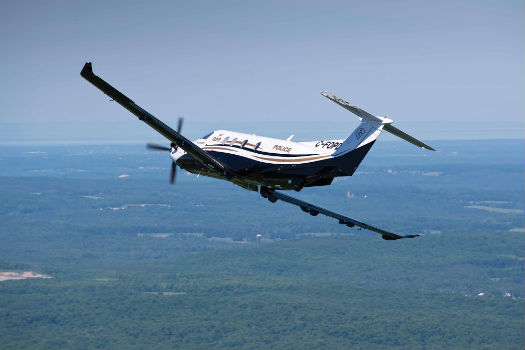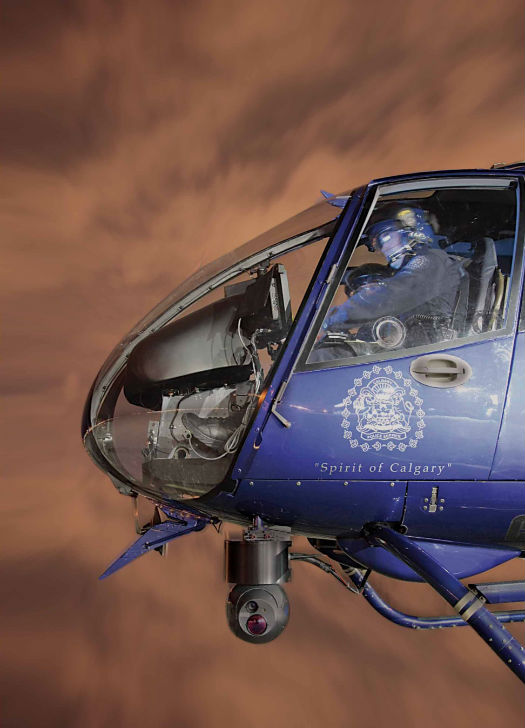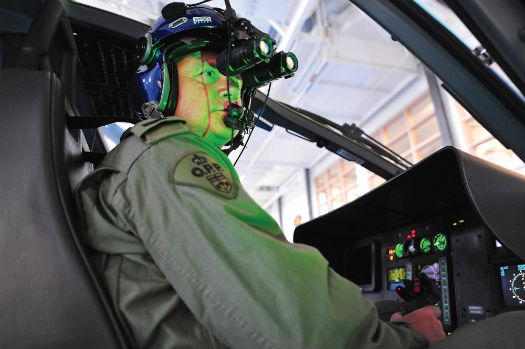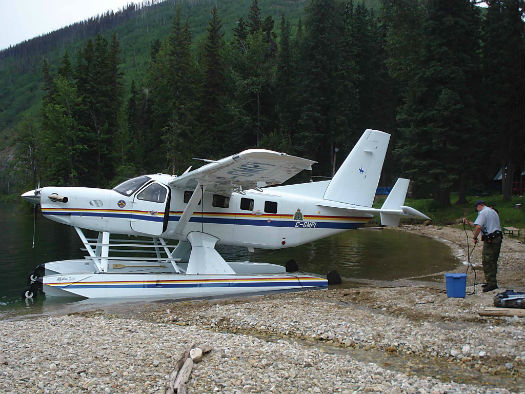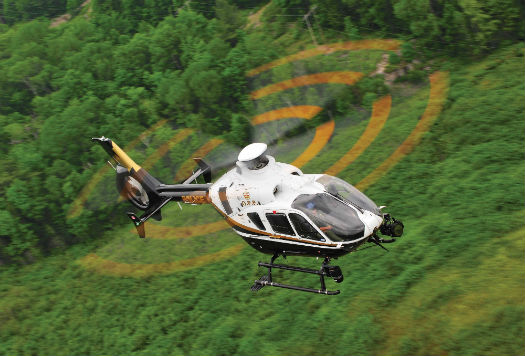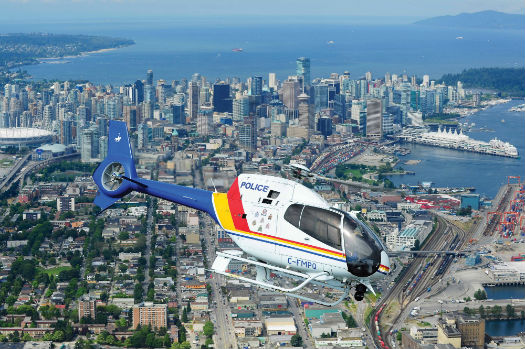The Calgary Police Service air support unit includes two HAWCS (Helicopter Air Watch for Community Safety) Airbus Helicopters H120 helicopters.
Very early on the morning of Oct. 8, 1993, Calgary Police constable Rick Sonnenberg was attempting to lay down a spike belt to apprehend a stolen vehicle speeding down the city’s Deerfoot Trail. The young officer was struck by the charging car and killed instantly.
“That was kind of the catalyst that spurred Calgary to really start making a move on getting a helicopter,” said Cameron Dutnall, chief pilot of the Calgary Police Service’s air support unit. “It was his sister who picked up the movement, creating the Sonnenberg Memorial Society, which raised the funds to buy a helicopter.” An MD 520 entered service in 1995. The air support unit has since grown to include two HAWCS (Helicopter Air Watch for Community Safety) Airbus Helicopters H120 (formerly EC120) helicopters.
The tragic event in 1993 also highlighted the value of airborne law enforcement—most police forces that employ air support continue such pursuits more safely from the air, in concert with ground forces.
The OPP’s Pilatus PC-12NG, based in Thunder Bay, is a people mover that transports personnel into remote areas, or retrieves arrestees within North America. Queen’s Printer for Ontario, 2015. Reproduced with permission.
Yet, airborne policing assets aren’t just for pursuit situations. “During front line patrol support and in response to a bank robbery call, an intrusion alarm or a suspect apprehension, air support will arrive first, quicker and safer, avoiding ground traffic and relaying valuable information to ground support officers as they are arriving,” explained Robert O’Quinn, Canadian director of the Airborne Law Enforcement Association (ALEA).
He added that there are many other applications that aren’t related to crime. “If we consider that an airborne asset can cover more ground faster, both visually and with enhanced abilities like FLIR (forward-looking infrared) and night vision, we realize how valuable this asset is when we are searching for a missing vulnerable person or a lost child,” he added. “I can recall many missing person events where air support has made the difference and saved a life, due to extreme cold weather and quick victim location.”
Calgary’s air support unit conducts regular patrols day and night, seven days a week, from its airport base. “We have a duty crew room there,” said Dutnall. “They have a police radio and are also logged into the Calgary Police network. They can launch right from the hangar.”
The York Regional Police Airbus Helicopters H120 (foreground) flies in formation with the Durham Regional Police Bell 206B.
The majority of flight time is patrol, he continued. “Think of us like a police car in the air.” Crews’ 11-hour shifts average around five flight hours, giving them the ability to respond quicker to calls. “There are some operations more suited to car patrol,” said Dutnall. “But, say for a home invasion, we would certainly respond. If we can get there and see the bad guy leaving the building, then we can follow them. But if it’s a domestic dispute, especially if ground units are already on the scene, we may not respond.”
Dutnall, who flew Bell UH-1N Twin Huey, Bell CH-146 Griffon and AgustaWestland CH-149 Cormorant helicopters over a 20-year career with the Canadian Armed Forces, believes strongly in the value of airborne law enforcement.
“There was a statistic I read many years ago that said one aircraft is worth about 14 police cars, just for its field of view. But I have always thought of it from a deterrent effect. We will never know what crimes we are deterring just by flying over.”
Airborne policing assets aren’t just for pursuits. They also provide front line patrol support, relaying valuable information to ground officers.
There’s another important aspect to air support that is felt when ground officers are on scene awaiting backup. “We can put a spotlight on them and it tells the bad guy we are onto them, and gives them second thoughts about trying something,” said Dutnall.
Calgary is Canada’s western-most city with police helicopters. Edmonton employs two, but “the Vancouver Police Department (VPD) does not have its own helicopter; instead, it utilizes the services of the Royal Canadian Mounted Police (RCMP) Air 1 helicopter when needed,” said Randy Fincham, media relations officer with the VPD. The city force provides a full-time spotter.
Further east, Saskatoon is somewhat unique in Canada, employing a Cessna 182S Skylane to perform much the same role as other police forces’ helicopters. “Our primary role is patrol response,” said Sgt Wade Bourassa, a pilot with the Saskatoon Police air support unit. “Similar to what you’d see in Calgary—patrol and investigative units.”
The Saskatoon Police air support unit takes a unique approach to airborne law enforcement, utilizing a Cessna 182S Skylane instead of a helicopter. Saskatoon Police Photo
Bourassa is sold on the cost-effectiveness of the Cessna over a helicopter. “We are running at about $200 per hour,” he explained. “If you look at what it costs to purchase, we don’t even enter into that equation. We are talking about a few hundred thousand bucks a year to operate our unit. If you’re talking helicopter, it’s anywhere from a thousand to $1,500 per hour.”
Bourassa said that high cost results in a lot of police forces dispatching their helicopter on an as-needed basis only. “And, once you’re beyond the cost advantages, you enter into the operational advantage/disadvantage conversation. I don’t know how many times I’ve heard stories about the helicopter acquiring a bad guy visually on a pursuit, that had to disengage because they had to return to base for fuel. We can carry seven hours’ fuel.” He reckons they can loiter as efficiently, too. By judiciously managing engine settings and dropping flaps, they can fly at 80 knots. “If you look at our video footage, you’d have no idea we’re in a fixed-wing.”
As with most forces, Saskatoon works joint operations. “We work a lot with the RCMP,” said Bourassa. “We help them on local missions, but are also tasked with some specialized missions.”
Two thirds of the OPP’s flying in any given year is related to search and rescue.
The Winnipeg Police Service prefers to employ a rotary wing asset. Its Airbus Helicopters H120B, purchased in 2010, has amassed over 4,000 hours, according to Rob Duttchen, unit coordinator for the Winnipeg flight operations unit.
When it comes to qualified pilots, Winnipeg prefers a hybrid approach. “We have two civilian pilots and one police officer who is also a pilot,” he said. Winnipeg’s mandate is to provide support throughout the province of Manitoba, and they maintain a reciprocal working agreement with the Department of National Defence. “We provide joint support for training and they support our flight safety program,” explained Duttchen. The daily routine is also a hybrid model, including some regular patrol and standby when not patrolling.
Duttchen fully supports air ops. “It provides ground units with an overview of the tactical situation,” he said. “It allows them to go in having an idea of what the threat is and where it’s located. So, by the time they are approaching to engage, they have an idea of the threat.” And, as things progress, the helicopter crew can give real time updates. If a suspect flees, the aircrew can pinpoint their last location so police dogs can have a track with an endpoint. “The canine officer could be many minutes away, but if the subject goes to ground it doesn’t matter how long the canine officer takes to get there, he has laid down the scent track.”
If a suspect flees, air crew can report their location and track an incident as it unfolds.
Duttchen provides an example of airborne support value. “We had an abduction case where the suspect fled the jurisdiction to a rural area, using several vehicles, trying to evade police,” he recounted. “By tracking the incident from start to finish using the aircraft, we were able to use a joint-coordinated Winnipeg police/RCMP unit to apprehend the subject.” Duttchen figured that without airborne forces, there would have been no way to track the fugitive across country by conventional means.
On a per square kilometre basis, city police air units have nowhere near the area to cover as do national or provincial services, such as the Ontario Provincial Police. The OPP maintains a brand new Pilatus PC-12NG based in Thunder Bay, a Cessna 206 at Lake Simcoe Regional Airport, and two Airbus Helicopters H135s—one at OPP headquarters in Orillia, the other in Sudbury.
Helicopters can be used to move tactical forces into position for an operation.
Unlike the city forces, “two-thirds of our flying in any given year is search and rescue response,” explained Dan Mulligan, sergeant and helicopter pilot, Orillia OPP helicopter unit. “With our aging demographics, we are getting more and more dementia-related searches.” And, he added, there are a lot of drownings in Ontario, for which the helicopters support the force’s underwater search and recovery unit. “We will often transport them to the scene and take out a body.” They’ll respond to other policing needs on occasion, but don’t do designated patrols. “We are pretty much like firemen that way… strictly a response scenario as opposed to proactive patrols.”
The OPP’s Cessna is almost strictly confined to province-wide highway speed enforcement. “We have designated highway areas with marked lines,” said Mulligan. “We have an officer in the back with a stopwatch setup, and the pilot also has an excellent camera system to record pursuits or erratic driving.” It’s a lucrative pursuit. “That aircraft has paid for itself seven times over to date.”
The RCMP operates 38 aircraft, including this amphibious Quest Kodiak in Western Canada. Neil Penney Photo
The OPP’s Pilatus is a people mover. “We have personnel that need to be moved into remote parts of the province, e.g. for native policing,” said Mulligan. “And, it is used on occasion throughout North America for picking up homicide arrestees.”
The RCMP’s purview is the world’s second-largest country. So, much of its airborne inventory is used for transportation duties, too. The RCMP maintains a sizeable force: 38 aircraft in 19 air sections across Canada.
What do they all do? “The easiest ones to pick off are the H125s (formerly AS350s)—the rotary wing machines,” said Clifford Marshall, acting director general of air services/operations manager, RCMP air services branch. “They are used generally for patrol, as in the Lower Mainland in Vancouver, where they are doing aerial patrol and supporting policing activities on the ground. They are involved in search and rescue; they help bring in emergency response teams; they bring investigators to crime scenes.”
The OPP’s two Airbus Helicopters H135s do not perform regular patrols. They are used strictly on an as-needed response basis.
The RCMP has considerable geography to cover, and its Pilatus PC-12s are commonly used to bring members in and out of remote detachments, help with prisoner transfers, and deliver response teams. “We are the lifeline for those really remote areas where there are no roads or regular air service, so we provide direct support for those northern communities. We have aircraft based in Iqaluit, Yellowknife, and Whitehorse,” explained Marshall.
The air services branch is involved in many incidents annually, but recently, those that stick in the public’s mind are the Moncton, N.B., event “where we had airborne support looking for Justin Bourque after he killed three members of the RCMP and wounded two others,” said Marshall. “And, (during the October 2014 shootings) on Parliament Hill, we provided aerial surveillance of the area. We had aircraft in the air from basically just after the shooting until well into the evening, when the downtown area lockdown was lifted.” Marshall said other roles played by RCMP aircraft include joint operations with the Coast Guard, Canadian Border Services Agency, and other policing organizations where needed.
The Vancouver Police Department does not have its own helicopter. Instead, it calls upon the RCMP when aerial assistance is needed. Here, an RCMP Airbus Helicopters H120 flies over the city.
The RCMP isn’t the only force challenged by geography. The Sûreté du Québec (SQ), for example, covers over 1.6 million square kilometres, encompassing more than a million lakes and watercourses. So, like the OPP, the force is extensively involved in search and rescue as well as crew transport and tactical operations. The SQ employs three Bell helicopters: a 206 LT, a 206 B and a 412 EP.
“Airborne law enforcement is worldwide in its applications,” summed up O’Quinn of ALEA. In Canada and around the world, his association represents more than 3,000 members, at both the international and local levels. With the value of airborne law enforcement clearly proven, O’Quinn said the ALEA is focused on delivering proven safety management systems, networking opportunities and educational seminars to promote a “safer world of flight.”

